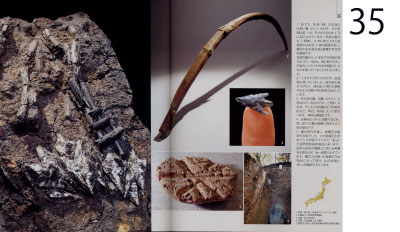1 (p. 34):
This is an arrow. At the tip of the arrowshaft is a sharp arrowhead, and the lower end of the arrowshaft is carved to a V shape in order to set a string (see the three pieces placed on the arrowshaft). At the V shape, there are traces of three arrows. This is an important archaeological finding that indicates the figure of Jomon arrows.
The length from the arrowhead to the V-shaped arrowshaft is 50 to 60 cm. The arrowshaft is made by vertically dividing a hydrangea paniculata that is easy to split due to its hollow inside.
2 (top, p. 35):
An arrow made of hydrangea paniculata, which was preserved in low, damp land. Decorated arrows for ceremonial use that are wrapped with cherry tree bark or painted with lacquer have been excavated from various places.
3 (middle, p. 35):
An arrowhead. The shape varies, from triangular to V shape and arrow shape, depending on the time period and region. The material is obsidian.
4 (bottom left, p. 35):
A whetstone, used as a file, with many concavities of the same depth in every direction. These concavities are for putting an arrowshaft upright for adjusting.
5 (bottom right, p. 35):
Obsidian was the best material for knives throughout the Jomon period. There is a “mine” near the Wada Pass in Nagano prefecture, where people dug in search for obsidian.
They dug more than three meters deep in order to collect obsidian mixed with white pyroclastic flow deposits. The mine pit that the Jomon people dug remains as a depression, and 195 spots are confirmed on a hillside in this area.
